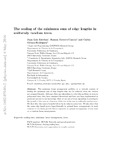The scaling of the minimum sum of edge lengths in uniformly random trees

Use this link to cite
http://hdl.handle.net/2183/19279Collections
- Investigación (FFIL) [885]
Metadata
Show full item recordTitle
The scaling of the minimum sum of edge lengths in uniformly random treesDate
2016-06Citation
Juan Luis Esteban, Ramon Ferrer-i-Cancho and Carlos Gómez-Rodríguez, The scaling of the minimum sum of edge lengths in uniformly random trees, Journal of Statistical Mechanics: Theory and Experiment, (2016):063401, 2016.
Abstract
[Abstract] The minimum linear arrangement problem on a network consists of finding the minimum sum of edge lengths that can be achieved when the vertices are arranged linearly. Although there are algorithms to solve this problem on trees in polynomial time, they have remained theoretical and have not been implemented in practical contexts to our knowledge. Here we use one of those algorithms to investigate the growth of this sum as a function of the size of the tree in uniformly random trees. We show that this sum is bounded above by its value in a star tree. We also show that the mean edge length grows logarithmically in optimal linear arrangements, in stark contrast to the linear growth that is expected on optimal arrangements of star trees or on random linear arrangements.
Keywords
Scaling laws
Minimum linear arrangement
Trees
Minimum linear arrangement
Trees
ISSN
1742-5468





